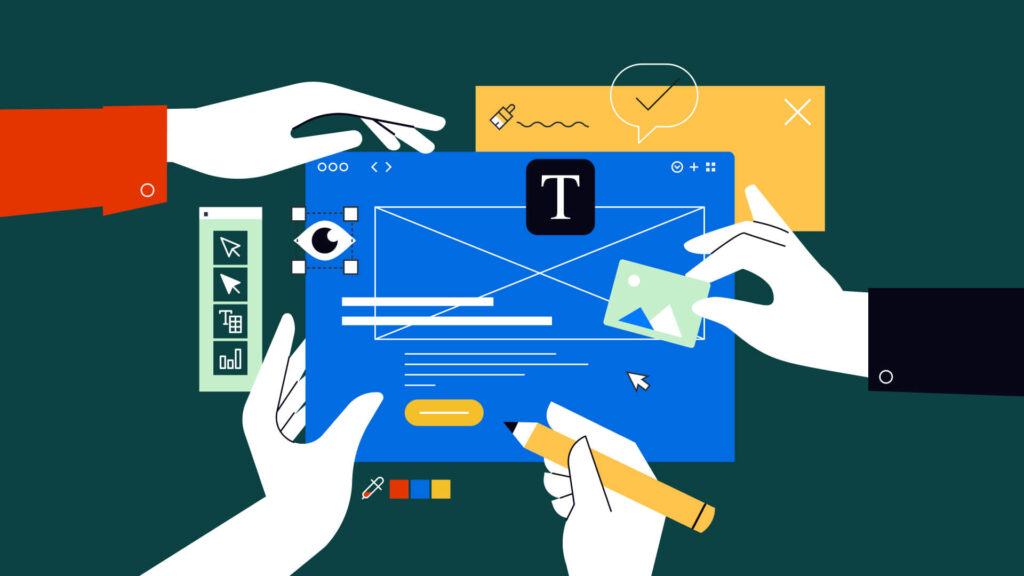While tools like Canva have reigned supreme for quick, templated asset creation, Figma Buzz is shaking up the landscape with a blend of deep design DNA and new-age automation. But what makes Buzz different, and why should you consider switching (or supplementing) your current workflow?
This blog isn’t just another feature rundown. We’ll explore actual workflows, clever tricks, honest limitations, and how Figma Buzz can change the way your team creates brand assets.
Why Marketers Should Pay Attention to Figma Buzz
Figma Buzz isn’t just another design tool—it’s a powerful enabler for modern marketing teams that need to produce high volumes of content while staying on brand. Here’s why it matters:
- Reduces reliance on designers for every new asset
- Accelerates campaign launches with scalable templates
- Bridges the gap between brand consistency and speed
- Provides non-designers with structured creative autonomy
With Buzz, marketers can own more of the asset creation process without compromising on quality or brand control.
The Problem with Traditional Asset Workflows
Even high-performing marketing teams face common frustrations:
- Design bottlenecks: Creative teams can’t always keep up with fast-moving marketing timelines.
- Lack of brand consistency: Assets made across tools and teams often drift from guidelines.
- Repetitive asset requests: Designers are flooded with minor edit requests.
- Scattered asset storage: Files get lost across folders, tools, and inboxes.
These challenges slow down go-to-market strategies and frustrate teams. What marketers need are scalable solutions that balance speed, control, and consistency. That’s exactly where Figma Buzz fits in.
How Figma Buzz Works — And What Makes It Different
A New Home for Brand Assets
Figma Buzz is built around template-based creation. Designers can set up flexible, on-brand templates while marketers use them in a controlled editing environment. The UI is intuitive and tailored for marketing use cases, making it easy for non-designers to jump in and create.
Bulk Asset Creation with Spreadsheet Power
Buzz allows you to connect a spreadsheet (preferably Google Sheets) to your template. You can populate it with campaign data—like headlines, dates, quotes, or image links—and Buzz will auto-generate hundreds of assets with that content. It’s one of the most powerful productivity features for marketing teams running campaigns across multiple platforms.
AI That Speeds You Up, Not Slows You Down
Buzz includes built-in AI tools to help you:
- Translate copy
- Rewrite and adjust content
- Auto-generate visuals or background images
These features eliminate time-consuming manual tweaks and let you stay focused on the big picture.
Grid View, Frame Presets & Smart Variants
Managing many assets at once is easy with Buzz’s grid view. You can see your entire campaign layout at a glance, adjust sizes, or duplicate assets. With built-in frame presets (for Instagram, LinkedIn, Facebook, etc.), you can create multiple versions of each asset with minimal effort.
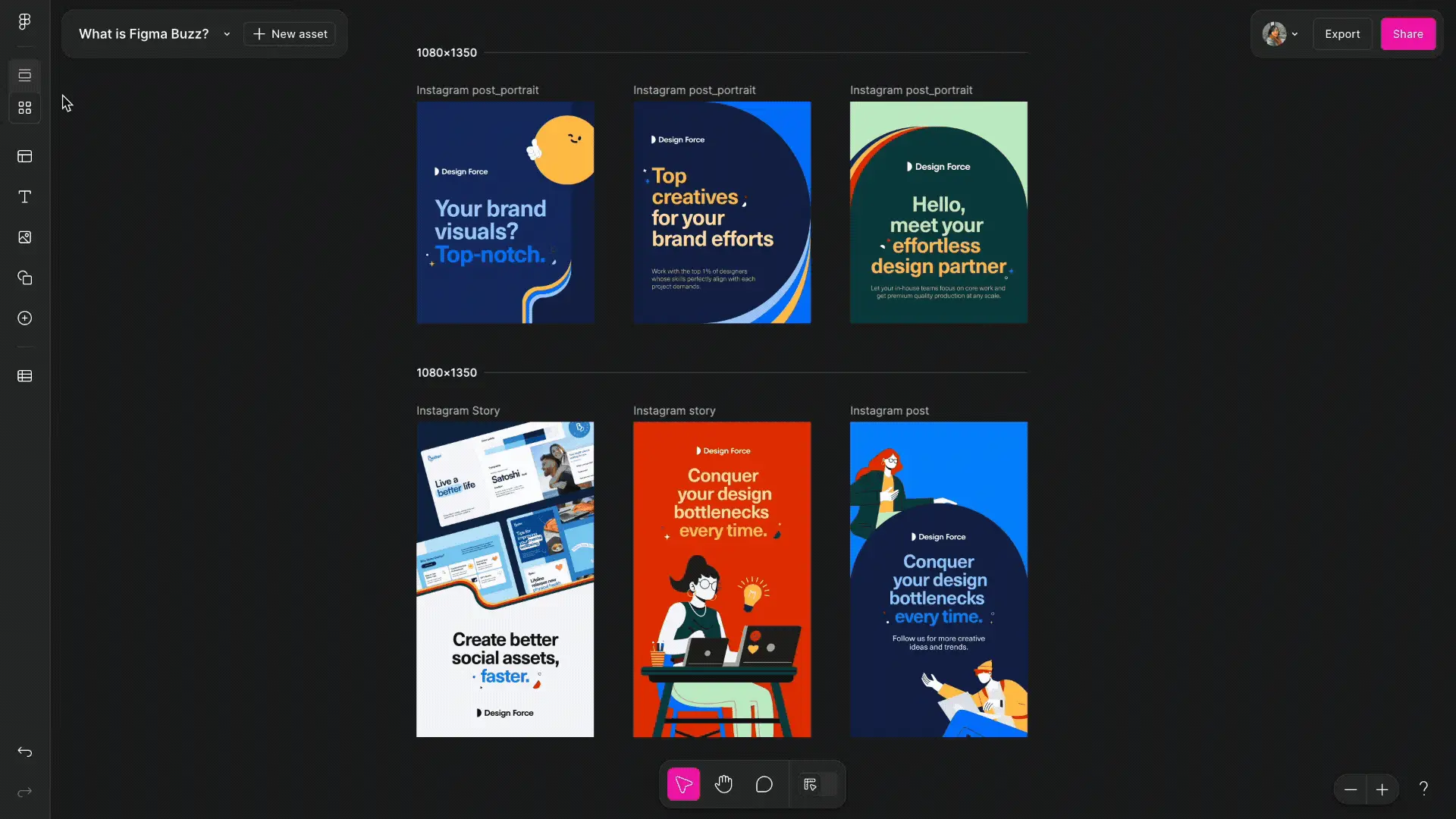
A Hands-On Look at Buzz’s Key Features
Let’s dive deeper into the practical experience of using Buzz, combining insights from real users and a recent hands-on walkthrough.
Real-Time Asset Customization
- Add, edit, and format content directly in the canvas
- Quickly change backgrounds, images, shapes, and layouts
- Switch into Design Mode to access full Figma features when needed
- Label your layers clearly to enable clean bulk imports
Content Management Meets Design Simplicity
- Organize all your assets with project folders
- Use the left-hand content panel to manage elements intuitively
- Insert components, icons, or “stickers” from community and team libraries
- Jump between list and grid views to streamline review and QA
Output Control & Export Options
- Export selected assets or the entire batch
- Format options: PNG, JPG, PDF (no SVG yet)
- Rename and group assets with bulk tools
- Choose custom sizes and asset labels
Buzz Mode vs. Design Mode: A Dual-Editing Paradigm
Figma Buzz offers two editing modes that make it uniquely flexible:
- Buzz Mode: Optimized for speed and simplicity, it’s perfect for marketers who need to change copy, swap images, and adjust colors while keeping brand integrity intact.
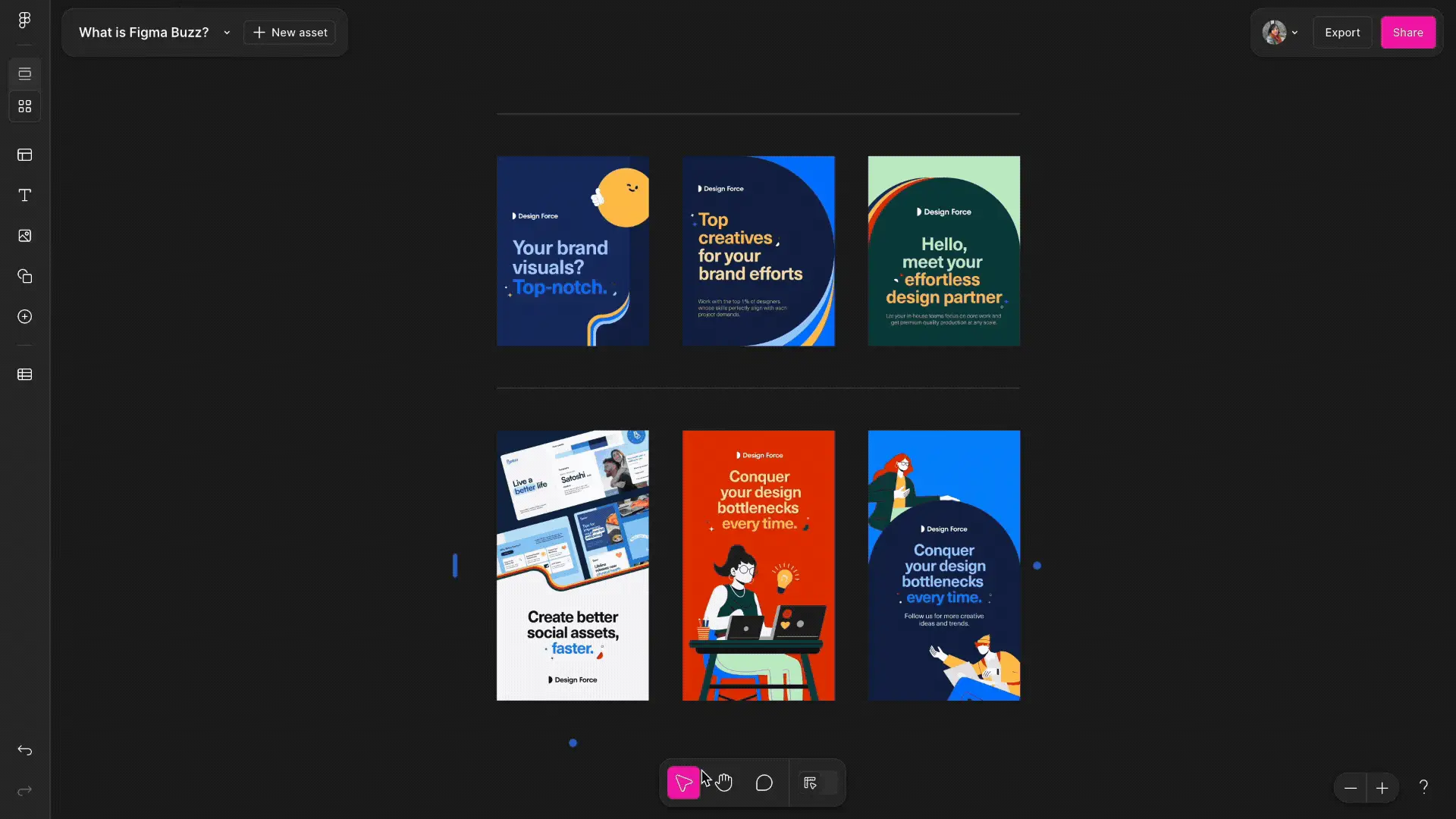
- Design Mode: For deeper control, switch to Design Mode to unlock advanced features like full font selection, resizing constraints, component editing, and effects.
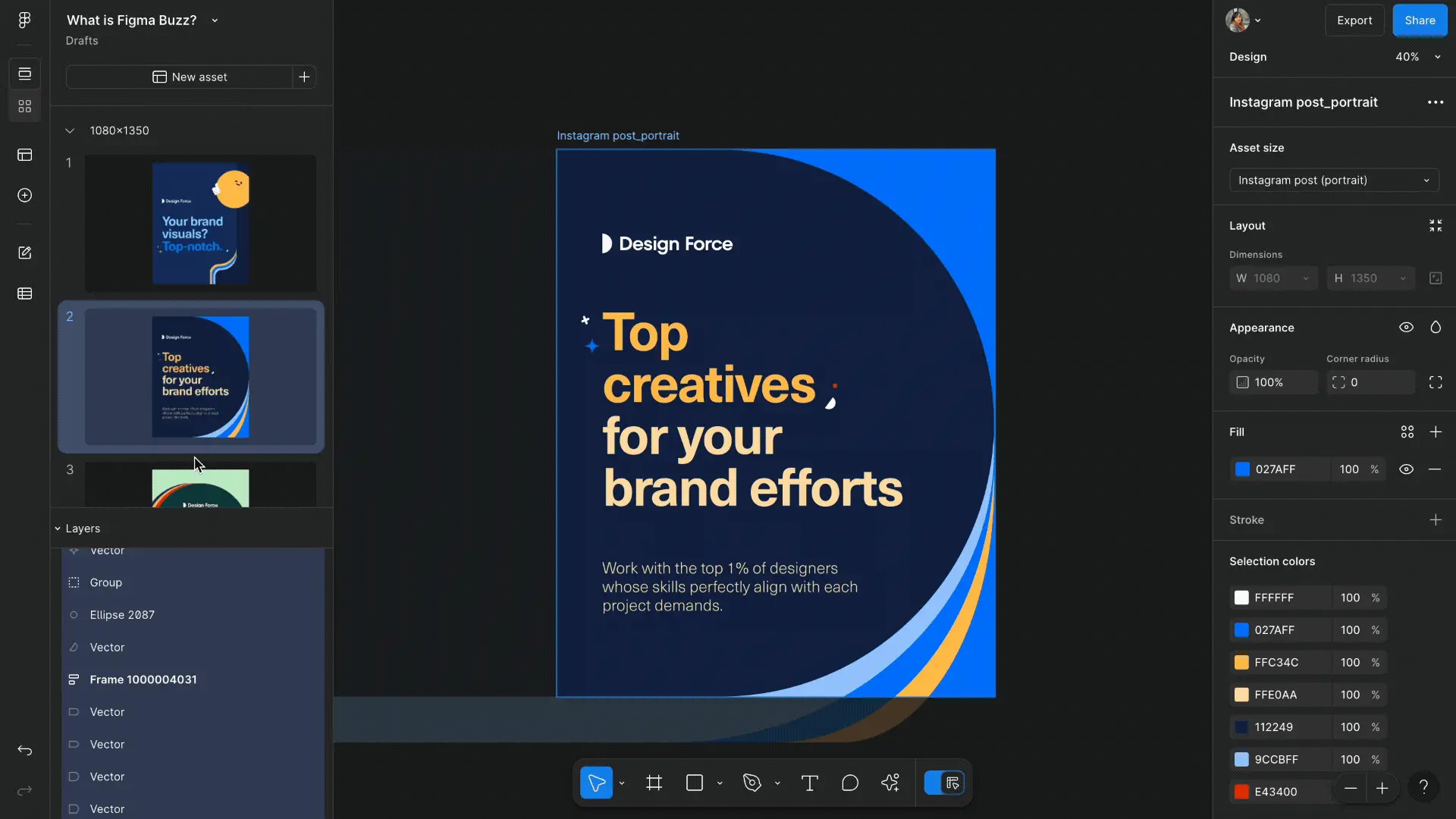
This toggle makes Buzz accessible for non-designers while still powerful for creatives who need precision.
Bulk Creation: A Marketer’s Dream for Campaign Scale
Figma Buzz excels in bulk asset production. Here’s how it works:
1. Create a spreadsheet (Google Sheets if using images) with headers like “quote,” “image,” “author.”
2. Upload to Buzz and map each column to elements on your template.
3. Click Create, and Buzz generates dozens (or hundreds) of assets based on your inputs.
4. Rename and export assets in bulk (JPG, PNG, PDF supported).
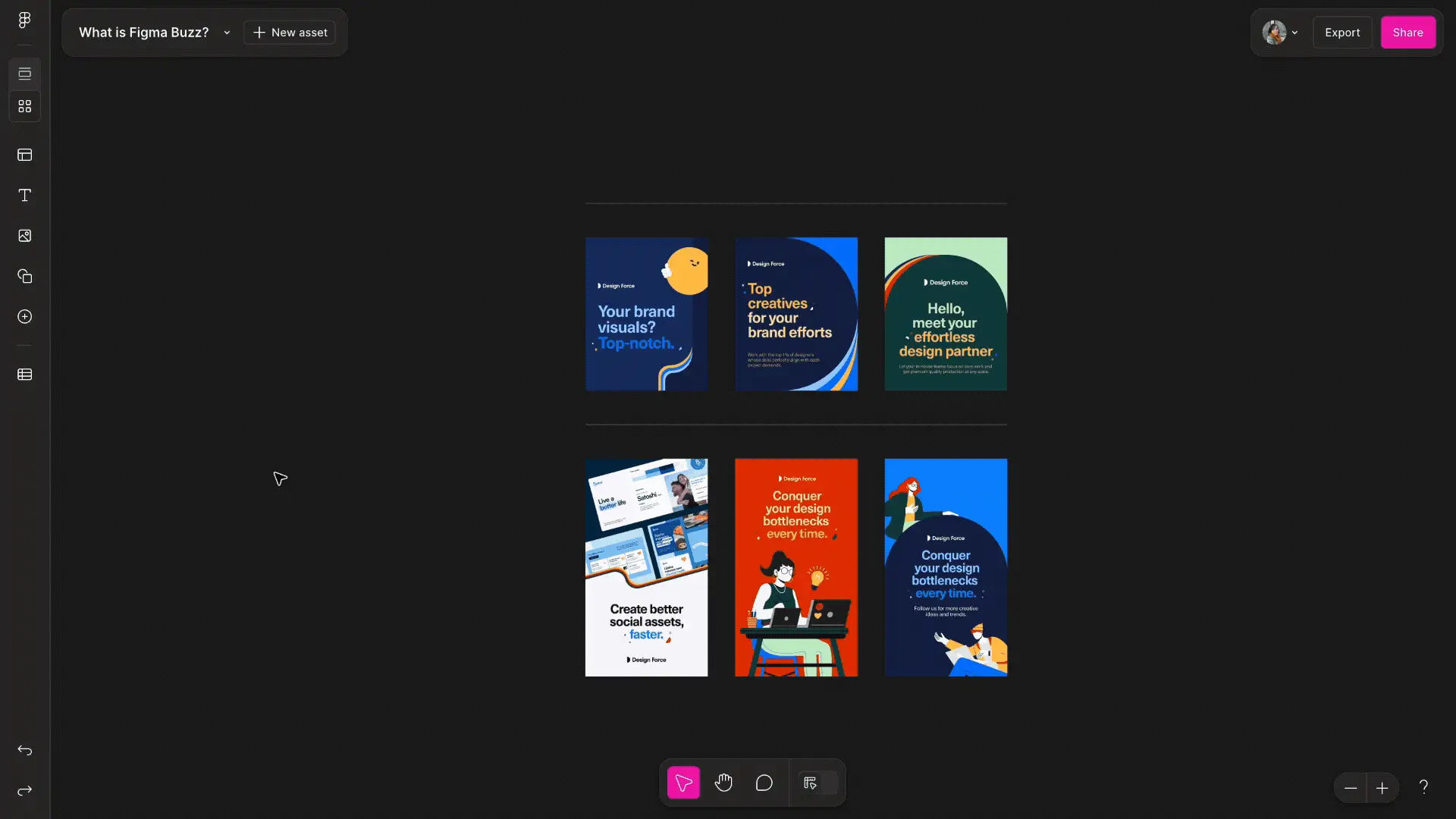
Whether you’re producing ads, social content, or event graphics, this feature saves hours and ensures consistency.
Customization Power: Templates, Inserts & AI Tools
Buzz gives you creative tools without overcomplicating the workflow:
- Templates: Choose from Figma’s library or use custom branded templates.
- Inserts: Like FigJam stickers, these are drag-and-drop assets from the community or your own design library.
- Text & shape tools: Easily adjust backgrounds, borders, effects, or fonts (with some limitations in Buzz Mode).
- AI assistance: Rewrite text, translate, or generate imagery directly within the app.
Limitations include restricted fonts in Buzz Mode and some quirks in text resizing—but switching to Design Mode removes most constraints.
Ready to scale design without the bottlenecks?
Real-World Workflow Advice: What Works, What Doesn’t
What works well:
- Empowering teams to create branded content fast
- Reducing back-and-forth between designers and marketers
- Streamlining repetitive tasks like localization or size variants
Pitfalls to note:
- No SVG or CMYK exports (yet)
- Limited formatting in Buzz Mode
- Spreadsheet setup must be precise (one image per cell)
Workarounds:
- Use Buzz for digital campaigns, and Figma Design for print or detailed adjustments
- Switch between modes to finesse your output
Figma Buzz vs Canva: How They Compare
For marketers and creative teams evaluating tools, Figma Buzz naturally invites comparison to Canva—one of the most popular design platforms out there. While both aim to streamline asset creation, their philosophies, use cases, and technical capabilities differ in meaningful ways. Here’s a quick breakdown to help you decide which tool—or combination of tools—makes the most sense for your workflow:
| Feature | Figma Buzz | Canva |
| Design Origin | Figma ecosystem, design-system-first | Standalone SaaS for drag-and-drop editing |
| Bulk Creation | Spreadsheet import, variable mapping | Some bulk tools, less flexible |
| Custom Fonts | Limited in Buzz mode, full in Design mode | Mostly open, but no real “design mode” |
| Print Export (CMYK) | Currently missing | Available in paid tiers |
| Template Access | From community or Figma templates | Vast built-in template library |
| Target User | Teams already in Figma, brand-focused orgs | Anyone from solo creators to teams |
| AI Capabilities | Built-in rewrite, translate, image generation | Broader set of AI tools (paid tiers) |
Buzz isn’t trying to be Canva—it’s focused on scalable, brand-safe design systems. If your team already works in Figma, Buzz is a natural fit.
Who Should Use Figma Buzz (and Who Shouldn’t)
Great for:
- Marketing teams running frequent campaigns
- Creatives supporting non-designer colleagues
- Agencies needing speed and control
Maybe not ideal if:
- You rely heavily on print production
- You need animation, interactivity, or full export support
- You’re entirely outside the Figma ecosystem
Many teams may benefit from a hybrid setup: Buzz for speed, Canva or Figma Design for specialty tasks.
Final Thoughts: Should You Add Buzz to Your Workflow?
Figma Buzz isn’t just a new tool—it’s a shift in how design and marketing collaborate. Its balance of structure and flexibility allows for scalable, brand-consistent asset production at speed. And as part of the Figma family, it naturally integrates into existing design systems.
While the tool is still evolving, it’s already powerful enough to make a difference in your team’s day-to-day work. Try it. Break it. See where it fits best.
At Design Force, we’ve helped teams streamline their workflows and unlock the full potential of tools like Figma Buzz. If you’re exploring how to scale your asset creation with more strategy and less friction, we’d love to chat, so contact us!
Want more tips like this? Sign up for our newsletter to get insights on design systems, scalable workflows, and the future of creative ops—straight to your inbox.

